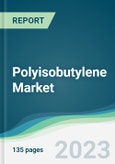The global polyisobutylene market was valued at US$2.833 billion in 2021.
Polyisobutylene (PIB) is a highly versatile synthetic rubber-like polymer derived from isobutylene, a valuable byproduct of petroleum refining. Its properties render it indispensable across various industries on a global scale. PIB's remarkable impermeability to gases and moisture grants it extensive utility in automotive components, particularly high-performance tires, which demand superior air retention capabilities. The global polyisobutylene market encompasses PIB's comprehensive production, distribution, and consumption worldwide. The market thrives primarily due to escalating demand for high-performance tires and automotive components, alongside the growing requisites of lubricants in diverse industrial sectors. Additionally, advancements in drug delivery systems employing PIB as an encapsulating agent significantly contribute to market expansion.Nevertheless, the polyisobutylene market confronts challenges. The volatility of raw material prices, particularly within the petroleum industry, influences production costs and overall profitability. Additionally, environmental concerns associated with petroleum-based products present obstacles, with mounting emphasis on sustainable alternatives. Furthermore, the market includes intense competition, with key players such as Braskem, Janex S.A, and ENEOS Corporation actively endeavoring to preserve and expand their market shares through continuous innovation and product development.
The polyisobutylene market is driven by increasing demand for personal care products and a surge in the need for controlled-release drug delivery systems.
Increasing automotive and personal care production - The growing automotive industry drives the demand for polyisobutylene in tire manufacturing and automotive components. According to the International Organization of Motor Vehicle Manufacturers (OICA), global automobile production reached approximately 85.06 million vehicles in 2022, which signified a 10% increase over 2020’s production volume. As the production of vehicles increases globally, the demand for high-performance tires and related products, which utilize polyisobutylene, is expected to rise. Due to its emollient and moisturizing properties, the personal care industry utilizes polyisobutylene in lipsticks, lip balms, and haircare formulations. The growing demand for personal care products globally contributes to the increased consumption of polyisobutylene.The pharmaceutical sector is witnessing advancements in drug delivery systems, particularly the demand for controlled-release formulations. Polyisobutylene is utilized in such systems to regulate the release of active pharmaceutical ingredients, contributing to sustained drug release over an extended period.
Market Developments:
- In February 2021, Kothari Petrochemicals Ltd introduced PIB R-01, a premium adhesive solution based on polyisobutylene. This high-quality, Ultra-strong - Tacky adhesive exhibits exceptional adhesiveness, specifically designed to control rodents and other crawling pests efficiently. The adhesive's immediate grip and remarkable stretchable hold make it an ideal choice for manufacturers specializing in RTG pads.
- In February 2021, BASF unveiled OPPANOL C, an innovative variation of polyisobutylene (PIB) which consists of PIB chips measuring one inch in size, providing streamlined processing capabilities that minimize both product development time and manufacturing steps. Notably, this non-toxic PIB boasts high purity levels and complies with the strict FDA food contact regulations, rendering it suitable for various applications. OPPANOL C retains the advantageous features of BASF's renowned high molecular weight PIB, such as exceptional barrier properties and adhesive qualities.
The high molecular weight segment is expected to witness robust growth.
The high molecular weight polyisobutylene (PIB) is experiencing a surge in demand within the polyisobutylene market, which can be attributed to its exceptional properties and versatile applications. Industries such as automotive, lubricants, adhesives, and pharmaceuticals are driving the demand for high molecular weight PIB. Furthermore, the expanding end-use industries such as lubricants and pharmaceuticals are creating opportunities for high molecular weight PIB. Its ability to act as a viscosity modifier in lubricants and a controlled-release agent in pharmaceuticals contributes to its market growth. Persistent research and development efforts are dedicated to enhancing the properties and performance of high molecular weight PIB. This ongoing innovation further boosts its market potential and opens avenues for new applications.Europe and Asia Pacific accounted for significant shares of the global polyisobutylene market.
Based on geography, the polyisobutylene market is segmented into North America, South America, Europe, Middle East and Africa, and Asia Pacific. The well-developed automotive and industrial sectors are driving the European polyisobutylene market. The region has stringent fuel efficiency and emission standards regulations, leading to increased demand for high-performance tires incorporating polyisobutylene. Moreover, Europe has a strong presence of lubricant manufacturers, and the demand for specialty lubricants, where polyisobutylene is used as a viscosity modifier, is high. Additionally, the region's focus on renewable energy sources and sustainable solutions creates opportunities for polyisobutylene in applications such as sealants and adhesives for wind energy installations. The personal care and pharmaceutical industries also contribute to market growth in Europe. The Asia Pacific region holds major shares of the polyisobutylene market due to rapid industrialization, urbanization, and increasing disposable incomes. The region’s construction industry also significantly utilizes polyisobutylene in sealants, adhesives, and roofing applications.Market Segmentation:
BY MOLECULAR WEIGHT
- High
- Medium
- Low
BY PRODUCT
- HR-PIB
- C-PIB
BY APPLICATION
- Automotive Components
- Fuel Additives
- Adhesives & Sealants
- Lubricant Additives
- Others
BY GEOGRAPHY
- North America
- USA
- Canada
- Mexico
- South America
- Brazil
- Argentina
- Others
- Europe
- Germany
- France
- United Kingdom
- Spain
- Others
- Middle East And Africa
- Saudi Arabia
- UAE
- Israel
- Others
- Asia Pacific
- China
- India
- South Korea
- Indonesia
- Thailand
- Taiwan
- Others
Table of Contents
1. INTRODUCTION
2. RESEARCH METHODOLOGY
3. EXECUTIVE SUMMARY
4. MARKET DYNAMICS
5. POLYISOBUTYLENE MARKET BY MOLECULAR WEIGHT
6. POLYISOBUTYLENE MARKET BY PRODUCT
7. POLYISOBUTYLENE MARKET BY APPLICATION
8. POLYISOBUTYLENE MARKET BY GEOGRAPHY
9. COMPETITIVE ENVIRONMENT AND ANALYSIS
10. COMPANY PROFILES
Companies Mentioned
- ENEOS Corporation
- LABDHI CHEMICALS
- Janex S.A
- TER Chemicals
- SABIC
- TPC Group
- Kothari Petrochemicals
- DuPont
- Braskem
Methodology

LOADING...








